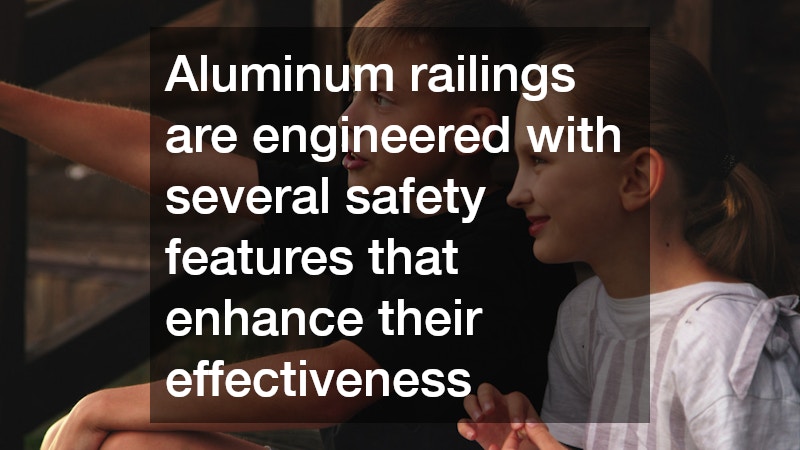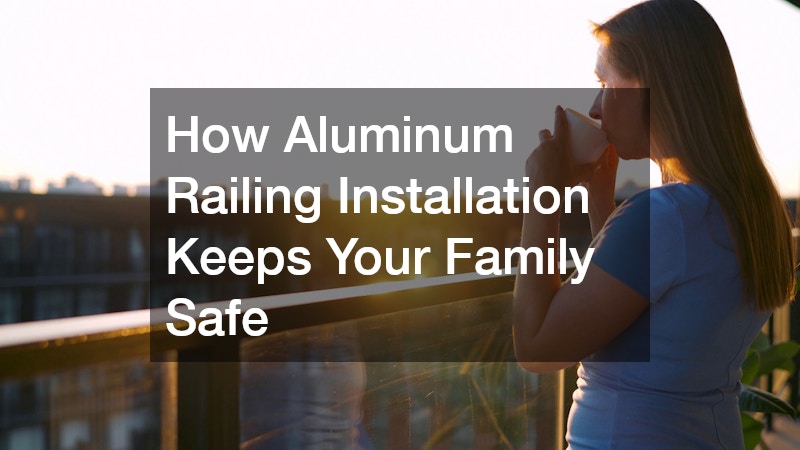Railings are an important safety feature in many homes. The proper installation of an aluminum railing can enhance your family’s safety. Learn the answers to common questions and understand insights into the benefits of aluminum railings.
Why Choose Aluminum Railings for Safety?
Aluminum railings have unique properties that make them an excellent choice for ensuring safety in residential environments. First and foremost, aluminum is known for its impressive strength-to-weight ratio, providing robust support without being overly heavy. This strength helps to prevent collapsing under weight, which is crucial for railings that are intended to help people navigate stairs or elevated areas safely.
Moreover, aluminum is naturally resistant to rust and corrosion due to a protective oxide layer that forms on its surface. This quality significantly enhances its longevity in various weather conditions, particularly in regions with high humidity or coastal exposure. Homeowners can feel confident that their railings will withstand the test of time, contributing to ongoing safety and peace of mind.
Aluminum also holds its color and finish better than many other materials, which means that it requires less maintenance to stay aesthetically pleasing. This durability ensures that the railings remain secure and visually appealing throughout their lifetime. Ultimately, choosing aluminum railings is a proactive measure to ensure a safer living environment for your family.
What Are the Key Safety Features of Aluminum Railings?
Aluminum railings are engineered with several safety features that enhance their effectiveness in keeping families secure at home. One key feature is the inherent strength of aluminum, which can support substantial weight and withstand considerable force, making it less likely to bend or break. This strength is essential for railings on staircases, balconies, and decks where there may be substantial movement.
Additionally, many aluminum railings come with options for adding caps, which can serve as an extra layer of safety. These caps minimize the risk of sharp edges or points that could pose a hazard in crowded or busy areas of the home. Moreover, the sleek design of aluminum railings often allows for clear lines of sight, contributing to visibility, which is particularly important in areas frequented by children and pets.
Another significant safety feature is the corrosion resistance of aluminum, which means that the railings maintain their structural integrity over time. Unlike wood, which can warp, splinter, or rot, aluminum remains reliable and strong, providing peace of mind for families who may otherwise worry about deteriorating materials. This unique combination of safety features makes aluminum railings a smart choice for any home.
How Does Proper Installation Affect Safety?
The safety of aluminum railings heavily relies on the quality of their installation. Engaging professional installers ensures that the railings are anchored securely to the structure of the home, which is critical in preventing accidents. Poor installation can lead to loose railings that may rattle or detach under pressure, posing significant risks to individuals relying on these barriers for support.
Furthermore, professional installers understand the nuances of local building codes and the specifications necessary for railings to be considered safe. They can accurately assess the unique requirements of your home, such as the height of the railings and the specific strength needed to comply with safety standards. This adherence to regulations guarantees that your railing installation is both safe and legally compliant.
Lastly, proper installation addresses potential weaknesses or flaws in the railings themselves. Even high-quality materials can fail if not installed correctly, leading to catastrophic accidents. Therefore, securing the services of trained professionals not only ensures compliance with safety regulations but also maximizes the protective attributes of aluminum railing systems.
Are There Building Codes or Regulations for Railing Installation?
Yes, there are specific building codes and regulations governing railing installations that are designed to enhance safety for homeowners. These codes typically outline the required height of railings, the materials that may be used, and the structural specifications for supporting posts and brackets. Familiarizing yourself with these laws helps ensure that your installation meets the necessary safety standards.
In many regions, local building codes mandate that railings on decks and staircases must be a minimum height, generally around 36 inches to 42 inches, depending on the application’s nature. Compliance with these height requirements reduces the risk of falls and improves overall security for residents. Regular inspections by local authorities guarantee that homes remain compliant, further emphasizing the importance of understanding and adhering to these regulations.
Additionally, building codes may address the spacing between balusters or pickets in aluminum railings, stipulating maximum widths to prevent small children from slipping between them. These regulations are established based on safety research and advocate for secure living environments. Ultimately, staying informed about local building codes and integrating them into your railing installation plan is essential for maximizing safety.
How Do Aluminum Railings Compare to Other Materials in Terms of Safety?
When comparing aluminum railings to other materials like wood and vinyl, several safety factors emerge that favor aluminum. For instance, wood railings can deteriorate and decompose over time due to exposure to moisture and environmental elements. This deterioration can create noticeable weaknesses in the structure, increasing the risk of accidents as wooden railings may fail under strain.
On the flip side, vinyl railings, while resistant to rot, can be less stable compared to aluminum, especially under extreme temperatures. In hot weather, vinyl can soften and potentially warp, while aluminum retains its structural integrity. This durability and resistance to temperature fluctuations make aluminum a strong contender in the safety department.
Furthermore, aluminum railings tend to be more visually unobtrusive, offering clear lines of sight compared to solid wood options, which are often bulkier. This transparency contributes to a safer environment as it allows for better visibility around the home, preventing accidents. Overall, aluminum railings stand out as a superior choice for both safety and aesthetics compared to their wood and vinyl counterparts.
Aluminum railings play a crucial role in safeguarding your family. By choosing the right materials, ensuring proper installation, and adhering to safety regulations, you can create a secure environment for your loved ones. The unique properties of aluminum, with its strength, corrosion resistance, and safety features, underscore its value as a reliable choice for railings. Understanding and complying with local building codes further enhances the safety and effectiveness of these systems. Ultimately, investing in aluminum railings is a proactive step toward ensuring the well-being of your family.






